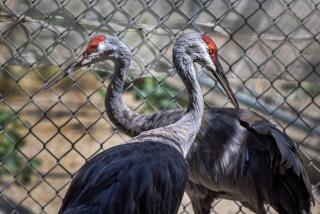Zoo Animals Are Up for Adoption
- Share via
BAKERSFIELD — Still looking for holiday gifts? Give some thought to exotic pets. Our national bird, for instance, the regal American bald eagle.
How about a mountain lion for the person who has everything? Wouldn’t young boys be thrilled by a gila monster? Or consider a lovable Holstein cow for your little girl.
Never mind about the food bills, medical care or cleanup chores. And don’t worry about where your family or friends are going to keep such creatures.
These memorable presents come with a trained staff to take care of them. And they already have a home.
It’s the California Living Museum, a sanctuary for orphaned, disabled or injured wild animals a few miles east of Bakersfield. To help care for these animals in this nonprofit sanctuary, people can adopt one for themselves or give them as gifts.
Imagine relatives and acquaintances receiving a certificate announcing that they are adoptive parents of a black-tailed deer or great horned owl. In addition, they’ll get a photo of the animal and guest passes to the museum to see their pet.
The California Living Museum may seem like a zoo to most visitors, but it’s really a place where people become acquainted with animals, birds, reptiles and plants found around California.
You’ll see creatures that are difficult to find in their own environment, such as the desert tortoise, which often lives in burrows. At the California Living Museum the tortoise exhibit features a subterranean walkway with glass panels so you can look at these rare turtles in their underground homes.
The museum started five years ago on a barren piece of Kern County land. It began as a dream of Mike Hopkins, the museum’s first director, who raised $500,000 in contributions to establish the preserve.
For a token fee, 88 acres are leased near Lake Ming and the Kern River. So far 13 acres are being used for the museum, which contains everything from a chuckwalla to a cougar, a Canada goose and even a cow.
There are 211 animals, representing 85 species, as well as 620 species of native California plants.
Most work is by volunteers. A few projects are still under construction, including a new habitat for birds of prey.
Visitors are welcome to take self-guided tours every day except Monday, from 10 a.m. till sunset. Admission $2.50, senior citizens $2, youths 6 to 17 years $1.50, and children 5 and under free.
Although somewhat isolated, the California Living Museum is not far from the main highway to Isabella Lake. From Los Angeles, head north on Interstate 5 to join California 99, then bypass downtown Bakersfield by taking California 58 east.
From that freeway, exit north on California 184 and pick up California 178 to continue east. Turn left (north) onto Alfred Harrell Highway, then drive right on Lake Ming Road. Just past the Rio Bravo Resort, look for the small California Living Museum sign and turn left on Frontage Road to the entrance.
It’s marked by the historic 1920s DiGiorgio home, which was moved to the site and will serve as an education and visitor center beginning next spring. In the meantime, entry tickets and guide maps are available in a house trailer.
That office also is where to arrange adoption of a museum creature at Christmas or any time of the year. All fees go toward food and veterinary costs for the wildlife.
Top fee is $1,000 for the endangered American bald eagle, which is expensive to feed because of its daily diet of salmon and trout.
But anyone can become an adoptive pet parent for $15, choosing from a kangaroo rat, a chuckwalla, a desert iguana, a leopard lizard, a ring-neck snake or a silky chicken.
Others are porcupine ($25), coyote ($50), burro ($75), kit fox ($100), black-tailed deer ($250) and mountain lion ($500).
Figure about two hours to stroll around the exhibits. If youngsters are along, plan extra time in which to feed mallard ducks and other waterfowl, as well as barnyard animals that include woolly sheep.
Also take time for the huge aviary, one of the largest in the state, where birds live as if they were in the wild. Keep your eyes open for a black-crowned night heron, American egrets, wild turkeys, quail, woodpeckers, doves and magpies.
Don’t miss the birds of prey exhibit, with owls, hawks and eagles that are unable to survive in the wild anymore. The magnificent golden eagle, for instance, has cataracts and can’t see to hunt.
For more information about the California Living Museum, or to get an adoption application, call (805) 872-2256. Or write to CALM, P.O. Box 6613, Bakersfield 93386.
Visitors can picnic at the outdoor museum, but the nearest and nicest place for a meal is the dining room at the Rio Bravo Resort; go back on Lake Ming Road.
Champagne brunch is served Sundays from 10 a.m. to 2:30 p.m.; reservations advised. Early bird dinner specials are available nightly from 5:30 to 7 p.m.
With heated swimming pools, 18 tennis courts (15 lighted for night play) and an 18-hole golf course, the resort is a pleasant spot to spend a night or two. Double room rates are $76. Call toll-free (800) 282-5000 or (805) 872-5000.
Round trip from Los Angeles to the California Living Museum is 234 miles.
More to Read
Sign up for Essential California
The most important California stories and recommendations in your inbox every morning.
You may occasionally receive promotional content from the Los Angeles Times.













